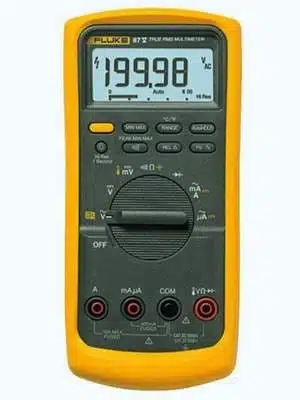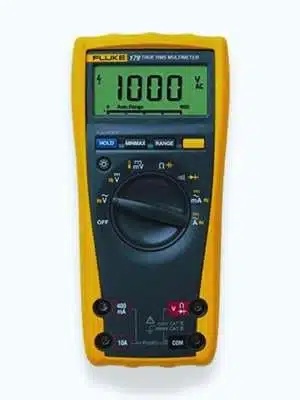When it comes to electrical measurements and troubleshooting, having a reliable and accurate multimeter is essential. Fluke, a renowned manufacturer of electronic test and measurement equipment, offers a wide range of high-quality multimeters that cater to the needs of professionals in various industries.
Two popular models from Fluke, the Fluke 87V and the Fluke 179 have gained significant recognition among electricians, technicians, and engineers. These multimeters are packed with advanced features and are designed to handle the demands of complex electrical work.
In fact, it is one of the most expensive digital multimeters on the market, which may have many people wondering whether to invest so much money in it. Now the question is Fluke 87V VS 179: Which one is Better?
If you are also wondering about this and are still torn between the two Flukes, read this article to find out which one is better. This article will tell you about the differences between these two models and help you to decide which one is suitable for your purpose.
In this blog post, we will dive deep into the Fluke 87V and Fluke 179 multimeters, exploring their similarities, differences, and unique capabilities.
Quick Comparision Table
The question of which multimeter, the Fluke 87V or the Fluke 179, is better ultimately depends on your specific needs and preferences. Both models are highly regarded and offer excellent
In this post, we’ll explain the Fluke 87V VS 179 pricing, features, pros, and cons of each multimeter. Further, we’ll also show the comparison tables of Fluke 87V and Fluke 179 after my honest and real testing.
Which one should you choose?

The Fluke 87V is marginally better than the Fluke 179. The larger screen on the 87V makes it easier to read and organize your data, which may be important when working with multiple wires and terminals at once like in an electric circuit. If budget is a concern, the fluke 179 true rms multimeter price could be a more cost-effective option as compared to 87V.
The two meters use different types of batteries but have similar battery life. Another thing that you need to consider is the price. You should consider how much you are willing to invest. If you need to purchase extra test leads, cables, or other accessories, then it will end up being more expensive than the 179.
However, if you only need a multimeter for routine work, then the Fluke 179 would be a good choice because of its lower price and better screen. There are many varieties of multimeters available on the market. It can be difficult to choose the right one.
Most of the new multimeters are much better than the older models in terms of performance, accuracy, and price. But it is not easy to compare them with each other because they have different features.
Fluke 87V Multimeter Review

The Fluke 87v max true-rms digital multimeter price is affordable and a desirable device because of its high performance, reliability, comfort features, and innovative design. It has a unique ability to measure both AC and DC voltage, resistance, and continuity in a single product. Its advanced circuit design makes the readings clear, precise, and reliable. The Fluke 87V is the most advanced multimeter from the Fluke family.
The Fluke 87V has many additional functions like temperature measurement, fast reaction time for high frequencies (up to 10MHz), measurement of pulse width modulation, etc. This device comes with a storage case to hold accessories like test leads and probes together in one place for easy access when needed.
Key Features
- The 87V is designed with user safety in mind.
- It offers both auto and manual ranging options.
- The 87V includes a built-in thermometer for measuring temperature.
What I Like/Dislike About Fluke 87V
Like:
- Lifetime warranty.
- Fast and responsive.
- Retains accuracy over time.
- True RMS waveform measurement.
- Dual resolution screen.
- Low pass filter for VFD work.
Dislike:
- Higher Side pricing.
- A little bit heavy for field operation.
Fluke 179 Multimeter Review

The Fluke 179 is a LED multimeter with a simple design, which is also very user-friendly. The front panel of the Fluke 179 has all the most commonly used functions to measure voltage and current, along with resistance and continuity.
Its backlight menu system makes it easy to navigate through the presets and make adjustments. The Fluke 179’s analog meter (VOM) lets you measure voltages in 1/10,000 of a volt range as low as 0.25 microvolts up to 1000 volts or about 675 amps.
Key Features
- It is designed to meet stringent safety standards.
- The Fluke 179 is equipped with capacitance and frequency measurement capabilities.
- The multimeter provides both auto and manual ranging options.
What I Like/Dislike About Fluke 179
Like:
- Great accuracy.
- Fast and responsive.
- Nice backlit display.
- sturdy and lightweight.
- Low pass filter for VFD work.
- Both manual and auto hold.
Dislike:
- No significant downsides.
We will compare the Fluke 87V and 179 on several points
The first thing that you should consider when comparing these two multimeters is their measurement accuracy. The comparison shows that both meters offer a basic accuracy of 0.05% and a span error of less than 0.10%.
The next thing you need to consider is the number of input channels on both meters. The Fluke 87V also has 8 channels, and the Fluke 179 has 4 channels. It can be useful for engineers who are into troubleshooting or testing many things at once.
However, the 179 only has 4 channels, so you will have to purchase extra test leads in order to get access to all eight channels.
The difference in screen brightness is quite surprising! Both these multimeters have a low light level screen with a very dim display. You cannot see the display clearly even when you use a light source. The Fluke 179 is brighter than the 87V, and it makes it easier to see the display.
Both these multimeters have a non-toxic, environmentally friendly body. The 87V has a rubber sleeve on the front. It is easy to carry around and not easily scratched by other things. It is available in blue, red, and green color variants, which makes it look better with different operating conditions.
What is a Fluke multimeter?
A multimeter is an electronic measuring instrument that allows the measurement of voltage, current, and electrical resistance. It uses a microprocessor to measure the parameters and display them on an LCD screen or print them on a thermal printer.
You can use it to check voltages and currents in electrical circuits, measure the resistance of components, and even find out if a component is faulty or not.
Fluke multimeters are best known for this reason they are portable, reliable, and easy to use.
Related: Fluke 287 VS 289: In-Depth & 100% Brutally Honest [2023]
Features of Fluke multimeter
Fluke multimeters come equipped with various features that make them stand out from the rest of the multimeters available on the market. Some of these features are listed below.
Fully automatic range selection: A lot of multimeters come with a range selector switch that is used to set the instrument to a specific range of measurement. However, Fluke comes with a fully automatic range selection feature that allows you to use any range without changing anything manually. This can be done by just turning the knob. The instrument will automatically switch ranges depending on what you need to measure.
Auto-ranges: The fluke multimeter features three auto-range selection modes that allow you to set it to different ranges of measurement depending on what is being measured. The first mode is for measuring voltage, the second is for current, and the third is for resistance. These modes are convenient because you don’t have to change anything manually to get the range you want.
Easy-to-read display and feedback indicators: The Fluke multimeter display shows you easily readable data in various categories.
Similarities Between Fluke 87V and 179
The Fluke 87V and Fluke 179 are both multimeters manufactured by Fluke Corporation, a renowned company specializing in electrical measurement and testing equipment. While they share some similarities, they also have distinct features. Here are the main similarities between the Fluke 87V and Fluke 179:
- Both the Fluke 87V and Fluke 179 are true-rms (root mean square) multimeters.
- Both models are built with durability in mind and are designed to withstand harsh environments.
- The Fluke 87V and Fluke 179 are designed with safety in mind and comply with various safety standards.
Why buy a Fluke brand multimeter like 179 and 87V?
There are several reasons why you might consider buying Fluke brand multimeters like the 179 and 87V. Here are some key points:
- Fluke multimeters are built to withstand harsh working conditions.
- Fluke prioritizes safety in their multimeter designs.
- Fluke is renowned for its high-quality products and is widely regarded as a trusted brand in the field of multimeters.
However, the Fluke brand’s reputation for quality, accuracy, durability, and customer support makes them a popular choice among professionals who rely on precise and reliable measurements in their work.
What is a True-RMS meter?
Conclusion
After carefully comparing the Fluke 87V and Fluke 179 multimeters, it is clear that both models have their own strengths and weaknesses. Ultimately, the best choice depends on the specific requirements and preferences of the user.
The Fluke 87V is renowned for its exceptional accuracy, durability, and robustness. It offers a wide range of advanced features such as True RMS measurements, temperature measurement capabilities, and excellent surge protection.
On the other hand, the Fluke 179 is a versatile multimeter that provides a good balance between functionality and affordability. While it may not offer the same level of accuracy as the 87V, it still delivers reliable measurements and a wide array of features.
Finally, If utmost accuracy, durability, and advanced features are your primary requirements, the Fluke 87V is the superior choice. It is an industry-standard multimeter that will meet the demands of professional users in various fields. However, if you are on a budget or need a versatile multimeter for general-purpose use, the Fluke 179 offers excellent value for money with its solid performance and extensive feature set. Ultimately, both models are reliable and trusted tools, and the decision should be based on individual needs and budget constraints.
Product Comparison Table
Here’s a comparison table highlighting the key features and specifications of the Fluke 87V, 179, and 289 multimeters:
| Feature | Fluke 87V | Fluke 179 | Fluke 289 |
|---|---|---|---|
| Display | Dual display with analog bargraph | Dual display with analog bar graph | Dual display with trend plot and digital graph |
| True RMS | Yes | Yes | Yes |
| Basic Accuracy | 0.05% | 0.09% | 0.025% |
| Voltage Range | Up to 1000V AC/DC | Up to 1000V AC/DC | Up to 1000V AC/DC |
| Current Range | Up to 10A AC/DC | Up to 10A AC/DC | Up to 10A AC/DC |
| Resistance Range | Up to 50 MΩ | Up to 50 MΩ | Up to 500 MΩ |
| Capacitance Range | Up to 9,999 µF | Up to 9,999 µF | Up to 9999 µF |
| Temperature Range | -200°C to 1090°C (-328°F to 1994°F) | -200°C to 1090°C (-328°F to 1994°F) | -200°C to 1350°C (-328°F to 2462°F) |
| CAT Safety Rating | CAT III 1000V, CAT IV 600V | CAT III 1000V, CAT IV 600V | CAT III 1000V, CAT IV 600V |
| Special Features | Built-in thermometer, low-pass filter | Built-in thermometer, low-pass filter | TrendCapture, data logging, and event logging |
| Price Range | Mid to high | Mid to high | High |
Related Articles
9 Best Multimeter for Automotive in any Budget (Reviewed)
9+ Best Multimeter for Electronics for Hobby, DIY & Repair
Fluke 101 Vs 107: My Honest Opinion After Using It!
Fluke 323 Vs 324: Clamp Meter Comparison Guide

1 thought on “Fluke 87V VS 179: My Honest Opinion After Using It!”